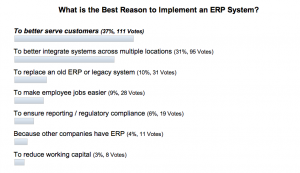ERP
Using ERP Systems to Increase Productivity

According to a recent poll on our website, easing the burden on employees is one of the key reasons why organizations across the globe implement ERP systems. Out of the roughly 300 responses we received in the poll at the time of this blog, 9 percent indicated that making employees’ jobs easier was their primary reason for implementing enterprise software (see below for poll results). This is in line with the data in our 2013 ERP Report, in which 10 percent of companies implemented new ERP systems to achieve just that goal.
But what is the benefit of making an employee’s job easier to the company? One word: productivity. An employee that is less weighed down by inefficient business processes, who can communicate cross-functionally with ease and who can access data with no concern for its validity is a productive employee. And a productive employee benefits the organization every time he or she comes into work.

But as good as this may sound in theory, most companies struggle to achieve these employee productivity benefits. In fact, again according to our 2013 ERP Report, 60 percent of organizations fail to realize at least half of the business benefits they expect, while nearly 50 percent reported that they did not realize improved productivity with their new system.
Part of the reason why companies struggle to achieve these business benefits is because they have not clearly articulated and quantified the details. What specific metrics will drive the business benefits and show us that we have realized them? How exactly will we achieve the business benefits, whether by implementing specific modules, reducing headcount or via some other driver?
All of these questions and others should be answered as part of an effective benefits realization plan. Here are a few tips to define a benefits realization plan that will ultimately drive the measurable results of your ERP implementation:
Begin with a quantifiable business case. In our 2013 ERP Report, we also found that 14 percent of organizations don’t have a business case to start with. Our experience shows that even those that do have a business case struggle to adequately build it in a way that actually drives results. More commonly, companies use very loosely defined or ambiguous benefit categories without much rigor behind the estimated results. In order to actually achieve the benefits, however, the business case needs to clearly define the expected impact on performance metrics, along with the who and how of achieving those results. Common productivity metrics include time spent on non-value-add activities such as gathering data and correcting mistakes resulting from incomplete information, but these metrics need to have tangible numbers attached to them to make them a reality.
Build your business process reengineering around the benefits realization plan. Quantifying business benefits is one thing, but operationalizing and realizing those benefits is another animal. Business processes need to be reengineered and clearly defined before measurable results come to fruition. One of the common pitfalls here is to define business processes and requirements in the context of the “current state” business processes as they exist today, rather than the “future state” context of a quantum leap forward for the company and its procedures. When facilitating business process reengineering activities, organizations must ask themselves, “How will this help us achieve the business benefits set forth in our business case and benefits realization plan?”
Leverage organizational change management activities to bring business benefits to life. Once business processes are clearly defined, they still need to be made operational and integrated into the organization, which simply won’t happen without an effective organizational change management plan. Organizational activities such as employee communications, change readiness, training, and change impact analyses should all provide the finesse required to ease employees’ transitions to the new processes and systems, while ultimately driving tangible user productivity benefits. If (and when) some of those benefits don’t materialize directly after go-live, an effective organizational change management strategy will ensure mid-course adjustments to optimize results in the longer term.
These are just a few tips to optimize employee productivity and other measurable business benefits. With an effective business case, business process management, and organizational change management tools and methods in place, your ERP implementation will be much more likely to achieve the business benefits you expect from your system. In other words, you’ll be one of the 40 percent that actually realizes a majority of the potential benefits of your software.
[This post originally appeared on Panorama Consulting’s 360 ERP blog and is republished with permission.]
Looking for more selection tips on ERP? Browse our entire archive of posts from industry experts by visiting the Selecting and Buying Software Tips section of the Business-Software.com blog.






